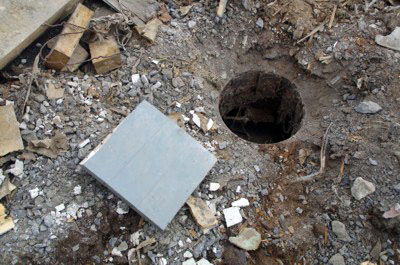Ed Wemp's Hotel
We have living-memory testimony that the building was a hotel around the turn of the century. In 1894 Ed Wemp bought Ham House from J. D. Ham's estate for $500 and presumably turned it into a hotel as he had at least another hotel in Millhaven. There was a 'window' opening between the centre hall and the dining room that might seem more indicative of a modern hotel.
The date 'September 13, '96' was written under the framing closing in the centre staircase of the store and this framing was made up of an east facade pilaster backing board and a 1.5" framing board from the centre hallway. It seems the centre hallway was opened up and the building re-sided in 1896. On all the millwork throughout the building there was a layer of purple paint that from wallpaper references was applied around 1896 - logically this was for the 'institutionalizing' of the building. From this it also seems that many of the interior doors in the house were replaced - only the door to the upstairs nursery, the staircase to upstairs and the door between the dining room and kitchen survived.
The 'store' end of the building was effectively erased in this period as the eastern door to the store was removed, a door punched through from the front foyer, and all interior partitions of the store removed and replaced with a single middle partition penetrated by a large Victorian archway. This established a front and back parlor.

Figure 1. Women's Toilet hole.
Under the addition at the back of the building were two metal sewage holding tanks with 15" round openings at the top, and overfills to terra cotta drainage beds. They were about 6' apart with the west tank located under the stairs and covered by the original flooring with a square hatch over the round opening. The east tank had been covered by a newer flooring and had been crumpled shut. It seems these were a 'his' and 'hers' toilet one-holers from the hotel days with the women's on the west. Within the west wall were dowels through the studs - presumably for towels in the women's washroom.
In 1898 Wemp severed the NW corner of the lot and sold it to William Hall for $52. Hall was a tinsmith and undertaker and presumably built his tinsmith shop on that lot.
In 1900 Wemp sold the remaining lot of Ham House to Marcelia and Theodore Edwards for $452. It seems given there was no markup in price from 1894, despite there being considerable work put into the building, it may have been the Edwards that were responsible for the 'upgrades' at Ham House and who actually ran the hotel.
In 1904, the Edwards sold Ham House to William Hall for $1000.
